
The Kingdom of Judah was an Israelite kingdom of the Southern Levant during the Iron Age. Centered in the highlands of Judea, the landlocked kingdom's capital was Jerusalem. Jews are named after Judah and are primarily descended from it.

Yahweh was an ancient Levantine deity, and national god of the Israelite kingdoms of Israel and Judah. Though no consensus exists regarding the deity's origins, scholars generally contend that Yahweh is associated with Seir, Edom, Paran and Teman, and later with Canaan. The origins of his worship reach at least to the early Iron Age, and likely to the Late Bronze Age, if not somewhat earlier.

Asherah is the great goddess in ancient Semitic religion. She also appears in Hittite writings as Ašerdu(s) or Ašertu(s). Her name was Aṯeratum to the Amorites, and Athiratu in Ugarit. Many scholars hold that Yahweh and Asherah were a consort pair in ancient Israel and Judah, although others disagree.

Ekron, in the Hellenistic period known as Accaron was a Philistine city, one of the five cities of the Philistine Pentapolis, located in present-day Israel.

An Asherah pole is a sacred tree or pole that stood near Canaanite religious locations to honor the goddess Asherah. The relation of the literary references to an asherah and archaeological finds of Judaean pillar-figurines has engendered a literature of debate.

Deir Alla is the site of an ancient Near Eastern town in Balqa Governorate, Jordan. The Deir Alla Inscription, datable to ca. 840–760 BCE, was found here.

Gath or Gat was one of the five cities of the Philistine pentapolis during the Iron Age. It was located in northeastern Philistia, close to the border with Judah. Gath is often mentioned in the Hebrew Bible and its existence is confirmed by Egyptian inscriptions. Already of significance during the Bronze Age, the city is believed to be mentioned in the El-Amarna letters as Gimti/Gintu, ruled by the two Shuwardata and 'Abdi-Ashtarti. Another Gath, known as Ginti-kirmil also appears in the Amarna letters.
William Gwinn Dever is an American archaeologist, scholar, historian, semiticist, and theologian. He is an active scholar of the Old Testament, and historian, specialized in the history of the Ancient Near East and the ancient kingdoms of Israel and Judah in biblical times. He was Professor of Near Eastern Archaeology and Anthropology at the University of Arizona in Tucson from 1975 to 2002. He is a Distinguished Professor of Near Eastern Archaeology at Lycoming College in Pennsylvania.
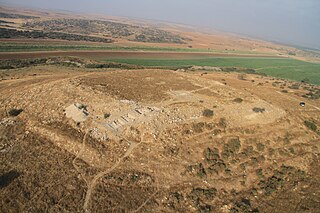
Tel Burna is an archaeological site located in the Shephelah, along the banks of Nahal Guvrin, not far from modern-day Qiryat Gat. Tel Burna is located near Beit Guvrin/Maresha, Tel Goded, Lachish, Tell es-Safi/Gath and Tel Zayit. The site is thought to have been one of a series of sites along the border between Judah and Philistia.
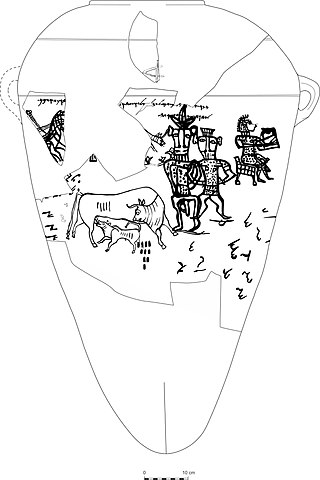
Kuntillet Ajrud or Horvat Teman is a late 9th/early 8th centuries BCE site in the northeast part of the Sinai Peninsula. It is frequently described as a shrine, though this is not certain. The Kuntillet Ajrud inscriptions discovered in the excavations are significant in biblical archaeology.
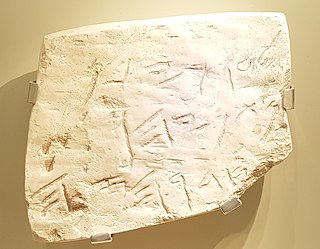
Khirbet el-Qom is an archaeological site in the village of al-Kum, West Bank, in the territory of the biblical Kingdom of Judah, between Lachish and Hebron, 14 km (8.7 mi) to the west of the latter.
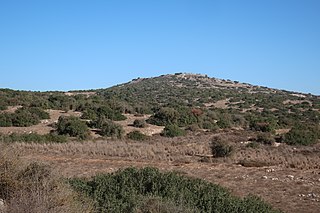
Tell ej-Judeideh is a tell in modern Israel, lying at an elevation of 398 metres (1,306 ft) above sea-level. The Arabic name is thought to mean, "Mound of the dykes." In Modern Hebrew, the ruin is known by the name Tell Goded.
A ceremonial pole is a stake or post utilised or venerated as part of a ceremony or religious ritual. Ceremonial poles may symbolize a variety of concepts in different ceremonies and rituals practiced by a variety of cultures around the world.
The Book of Joshua lists almost 400 ancient Levantine city names which refer to over 300 distinct locations in Israel, the West Bank, Jordan, Lebanon and Syria. Each of those cities, with minor exceptions is placed in one of the 12 regions, according to the tribes of Israel and in most cases additional details like neighbouring towns or geographical landmarks are provided. It has been serving as one of the primary sources for identifying and locating a number of Middle Bronze to Iron Age Levantine cities mentioned in ancient Egyptian and Canaanite documents, most notably in the Amarna correspondence.

Lavnin (Hebrew: חורבת לבנין)(Arabic: خربة تل البيضة), is a late Bronze Age archaeological site situated in Israel's Adullam region, rising some 389 metres (1,276 ft) above sea level. The site lies 8 kilometres (5.0 mi) northwest of Beit Gubrin, and about 1 kilometer west-north-west of Khirbat Umm Burj, directly south of Nehusha.

The Kuntillet Ajrud inscriptions refers to a set of jar and plaster inscriptions, stone incisions, and art discovered at the site of Kuntillet Ajrud. They were found at a unique Judean crossroads location that was among an unusual number and variety of vessels and other inscriptions. They date to the late 9th century BC in the Sinai Peninsula.
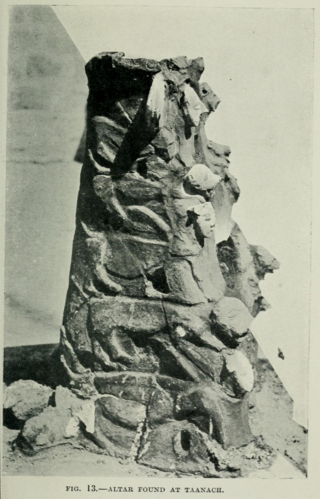
The Ta'anakh cult stand was found in the ancient city of Ta'anakh, near Megiddo, in Israel. It dates back to the 10th century BCE and has various images that are related to the religious practices of the Israelites. Some think that the "elaborate" 53cm stand was used for offering incense to the gods, while others suggest that it was a miniature representation of a temple or a shrine. The stand has four tiers.
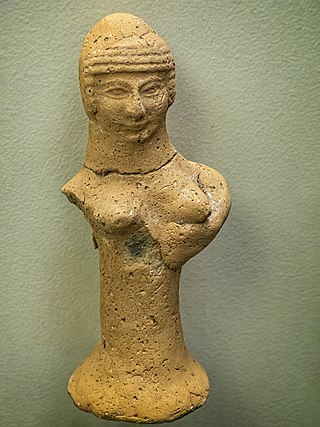
Judean pillar figures or figurines were ubiquitous household items in the Iron Age representing the Canaanite great goddess Asherah.
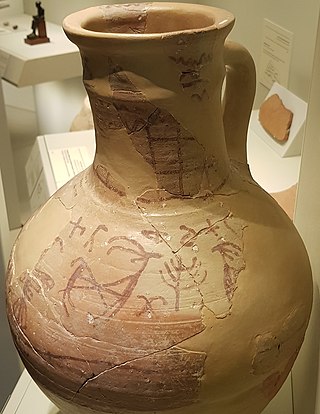
The Lachish ewer is an ancient jug discovered at Tell el-Duweir dating from the late 13th century BC, identified as the site of the ancient city of Lachish, one of the most important cities in the Kingdom of Judah.


















